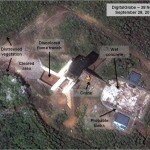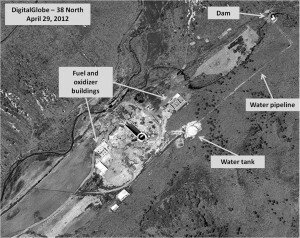Published on July 1, 2013
For Immediate Release
Media Contacts: Michelle Cann, Senior Budget and Policy Analyst, PGS (+1 609 668-2930); Kelsey Davenport, Nonproliferation Analyst, ACA (+1-317-460-8806); Sarah Williams, Nuclear Policy Analyst, PGS, (+1 202-332-1412).
 July 1, 2013: A new report released today by the Arms Control Association (ACA) and Partnership for Global Security (PGS), sponsored by the U.S.-Korea Institute at SAIS and the Fissile Materials Working Group, finds that the Nuclear Security Summit (NSS) process has catalyzed action to secure nuclear weapons-usable materials, but the largely nationally-focused efforts to date are inadequate, and leading governments must begin building the framework for a cohesive international nuclear security governance system.
July 1, 2013: A new report released today by the Arms Control Association (ACA) and Partnership for Global Security (PGS), sponsored by the U.S.-Korea Institute at SAIS and the Fissile Materials Working Group, finds that the Nuclear Security Summit (NSS) process has catalyzed action to secure nuclear weapons-usable materials, but the largely nationally-focused efforts to date are inadequate, and leading governments must begin building the framework for a cohesive international nuclear security governance system.
In the lead up to the Seoul Nuclear Security Summit in 2012, USKI published a paper reporting on the implementation of the national commitments pledged at the 2010 NSS in Washington. The 2013 edition of The Nuclear Security Summit: Progress Report provides a comprehensive overview of the progress states have made to improve nuclear security since the NSS process began in April 2010.
“The 2010 Washington summit and the 2012 Seoul summit focused primarily on accelerating incremental efforts at the national level, rather than building consensus for bold new actions,” said Michelle Cann, senior budget and policy analyst at PGS and co-author the report.
“Ahead of the 2014 summit in The Netherlands, states must begin outlining a global strategy to address the structural deficiencies of the current nuclear security regime,” she added.
“Although all 53 participating countries have taken steps since the 2012 summit to strengthen nuclear security, the current system lacks universal reporting requirements and standards, making it difficult to assess the overall progress of the summit process,” said Kelsey Davenport, nonproliferation analyst for ACA and co-author of the report. read more …
Published on May 17, 2013
The US-Korea Institute at SAIS is now the newest member of the Fissile Materials Working Group (FMWG). The FMWG has been a forceful presence in support of improved fissile material security and the prevention of nuclear terrorism. The FMWG meets regularly to address issues urgent to the nuclear security agenda and convene the summit of international experts on the sidelines of the Nuclear Security Summit. To find out more about the FMWG, visit http://www.fmwg.org/index.cfm.
Published on May 2, 2013
The U.S.-Korea Institute at SAIS (USKI) and the Global America Business Institute (GABI) are pleased to invite you to a speaker and discussion series featuring presentations on subjects relevant to the 123 Agreement between the US and South Korea:
Next Discussion
US 123 Agreements: Perspective of the Nuclear Industry
Guest Speaker: Amir Shahkarami, Senior Vice President and CEO, Exelon Nuclear Partners
Amir Shahkarami is Senior Vice President of Exelon Generation Company and CEO of Exelon Nuclear Partners, where he is responsible for all domestic and international business development projects. He has nearly 30 years of experience in the nuclear industry, with ten years at Exelon. Most recently, he was Exelon Nuclear Senior Vice President of Technical Services, in which he was responsible for nuclear fuel, engineering, project management, license renewal, industry organizations, innovation, and Exelon Nuclear’s international exchange program. Prior to joining Exelon, Mr. Shahkarami held several key positions of increasing responsibility at Entergy at several nuclear sites and corporate for ten years. He received his bachelor’s and master’s degrees in Engineering from Tulane University, his MBA from Mississippi College, and his Ph.D. in Nuclear Engineering from Louisiana State University.
Monday, May 13, 2013
2:00 – 3:00pm
Rome Auditorium
1619 Massachusetts Avenue NW,
Washington, DC 20036
RSVP: To register, please contact Alan Ahn at or
202-499-7978
.
Published on December 14, 2012
USKI’s Joel Wit and Jenny Town published an article on ForeignPolicy.com discussing what the successful North Korean rocket launch means for US foreign policy towards the DPRK. The Obama administration now faces the choice of how his record on North Korea will be remembered: a hard problem more or less contained or a rogue state armed with dozens of nuclear weapons well on its way to threatening the US. Obama’s second term is a second chance to tackle this important foreign policy issue. Is he up to the challenge?
Read the article “Launch This” at ForeignPolicy.com.
Joel Wit is a visiting scholar at the U.S.-Korea Institute at Johns Hopkins School of Advanced International Studies and founder of its North Korea website, 38 North. Jenny Town is a research associate at the U.S.-Korea Institute at Johns Hopkins School of Advanced International Studies and editor of 38 North.
Published on November 14, 2012
 While the North Koreans may have refrained from conducting a nuclear test and subsequent missile tests after their failed rocket launch in April 2012, recent satellite imagery shows that the North is still continuing development of their missile development and the launch pad at the Sohae Satellite Launching Station (Tongchang-ri). USKI’s 38 North was the first to report on these developments, analyzing imagery from DigitalGlobe. According to 38 North analysts, the North has conducted liquid-fueled rocket engine tests at the Sohae facility as recently as September, and has continuing improvements to the Sohae launch pad. Full analysis and satellite imagery can be found here: http://38north.org/2012/11/sohae111212/.
While the North Koreans may have refrained from conducting a nuclear test and subsequent missile tests after their failed rocket launch in April 2012, recent satellite imagery shows that the North is still continuing development of their missile development and the launch pad at the Sohae Satellite Launching Station (Tongchang-ri). USKI’s 38 North was the first to report on these developments, analyzing imagery from DigitalGlobe. According to 38 North analysts, the North has conducted liquid-fueled rocket engine tests at the Sohae facility as recently as September, and has continuing improvements to the Sohae launch pad. Full analysis and satellite imagery can be found here: http://38north.org/2012/11/sohae111212/.
Just after Barack Obama was re-elected to a second term as President of the United States and just a month before a hotly contested presidential race in South Korea, the developments at Sohae have reminded both candidates of why North Korea policy coordination in these new adminstrations is important and of the potential for provocations at the outset of the two Presidents’ terms.
See CNN coverage of the 38 North article here: http://www.cnn.com/video/#/video/world/2012/11/14/clancy-nkorea-rocket-test.cnn.
Published on July 19, 2012
USKI’s 38 North and Stanford University’s Center for International Security and Cooperation (CISAC) have launched new resources on the history of KEDO to help increase public understanding of what this project was and what it accomplished.
When the South Korean fast ferry Hankyoreh sailed out of North Korean waters into the cold wind and waves of the East Sea on the morning of 8 January 2006, it carried a sad and somber group of South Korean workers, ROK officials, and personnel from the Korean Peninsula Energy Development Organization (KEDO). These were all that remained of a decade long multinational effort transforming what in 1994 had been only a paper notion into a modern construction complex of steel and concrete. KEDO’s profile on the North Korean landscape was unmistakable, its impact on Pyongyang profound. Yet, real knowledge and understanding about the organization in public and official circles in South Korea, Japan, and the United States was terribly thin at the beginning, and remains so to this day. ~ A History of KEDO 1994-2006
 In conjunction with the release of CISAC’s new book, A History of KEDO 1994-2006–an oral history project meant to preserve what remains of the living memory about KEDO, of the thinking that went into setting up the organization, the efforts to coordinate plans and translate them to realities on the ground in North Korea, and the struggle to maintain a sense of sanity while KEDO was pushed and pummeled into disintegration–USKI’s 38 North launches a new video: “Reflections on KEDO.” In this video, Joel Wit (38 North founder and Visiting Scholar at the US-Korea Institute at SAIS), hosts a conversation with Ambassador Stephen Bosworth (former US Special Representative for North Korea Policy and current Dean of The Fletcher School at Tufts University) and Robert Carlin (CISAC Visiting Scholar), about their experiences with KEDO. All three were involved with KEDO at different times in its ten year history and provide insights into what it was like on the ground building this multilateral organization. They discuss some of the major challenges in dealing with the North Koreans, as well as the cultural learning curve faced by KEDO’s multicultural staff. From the perspective of direct experience, they examine both KEDO’s accomplishments and the opportunities missed by the organization’s abrupt termination. In the final segment, Ambassador Bosworth also reflects on the Obama administration’s North Korea policy and provides his views on how to improve relations with the North in the future.
In conjunction with the release of CISAC’s new book, A History of KEDO 1994-2006–an oral history project meant to preserve what remains of the living memory about KEDO, of the thinking that went into setting up the organization, the efforts to coordinate plans and translate them to realities on the ground in North Korea, and the struggle to maintain a sense of sanity while KEDO was pushed and pummeled into disintegration–USKI’s 38 North launches a new video: “Reflections on KEDO.” In this video, Joel Wit (38 North founder and Visiting Scholar at the US-Korea Institute at SAIS), hosts a conversation with Ambassador Stephen Bosworth (former US Special Representative for North Korea Policy and current Dean of The Fletcher School at Tufts University) and Robert Carlin (CISAC Visiting Scholar), about their experiences with KEDO. All three were involved with KEDO at different times in its ten year history and provide insights into what it was like on the ground building this multilateral organization. They discuss some of the major challenges in dealing with the North Koreans, as well as the cultural learning curve faced by KEDO’s multicultural staff. From the perspective of direct experience, they examine both KEDO’s accomplishments and the opportunities missed by the organization’s abrupt termination. In the final segment, Ambassador Bosworth also reflects on the Obama administration’s North Korea policy and provides his views on how to improve relations with the North in the future.
My personal conclusion was they [North Koreans] were very serious about what they were doing—the enterprise that we were involved in. This was not something just being done for show. For them, it was not just KEDO and the Agreed Framework and light water reactors, but it was clear for many of them this was important because it was setting a series of precedents for how North Korea could begin to engage with rest of the world in a more direct and active fashion. ~ Ambassador Stephen Bosworth, “Reflections on KEDO,” a 38 North interview
Find the 38 North video here.
Published on May 22, 2012
 New satellite photos from April 29, 2012 indicate that a major upgrade of North Korea’s Tonghae Satellite Launching Ground—more commonly referred to as Musudan-ri—underway since summer 2011, is making rapid progress. The new construction is intended to support future launches of rockets larger than the recently tested Unha—more capable liquid fueled space launch vehicles or missiles with intercontinental ranges—that will also overfly Japan, further aggravating regional tensions. In addition to a new launch pad under construction, much of the nearby village of Taepodong has been razed to clear the way for what appears to be a new building designed to assemble larger rockets. The high bay portion of that building—the area where rockets are assembled—may have twice as much floor space as similar facilities at Musudan-ri and the new Sohae Satellite Launching Station (commonly referred to as Tongchang-ri). At the current pace of construction, the facilities should be operational by 2016-17.
New satellite photos from April 29, 2012 indicate that a major upgrade of North Korea’s Tonghae Satellite Launching Ground—more commonly referred to as Musudan-ri—underway since summer 2011, is making rapid progress. The new construction is intended to support future launches of rockets larger than the recently tested Unha—more capable liquid fueled space launch vehicles or missiles with intercontinental ranges—that will also overfly Japan, further aggravating regional tensions. In addition to a new launch pad under construction, much of the nearby village of Taepodong has been razed to clear the way for what appears to be a new building designed to assemble larger rockets. The high bay portion of that building—the area where rockets are assembled—may have twice as much floor space as similar facilities at Musudan-ri and the new Sohae Satellite Launching Station (commonly referred to as Tongchang-ri). At the current pace of construction, the facilities should be operational by 2016-17.
Read the article at 38 North.
 July 1, 2013: A new report released today by the Arms Control Association (ACA) and Partnership for Global Security (PGS), sponsored by the U.S.-Korea Institute at SAIS and the Fissile Materials Working Group, finds that the Nuclear Security Summit (NSS) process has catalyzed action to secure nuclear weapons-usable materials, but the largely nationally-focused efforts to date are inadequate, and leading governments must begin building the framework for a cohesive international nuclear security governance system.
July 1, 2013: A new report released today by the Arms Control Association (ACA) and Partnership for Global Security (PGS), sponsored by the U.S.-Korea Institute at SAIS and the Fissile Materials Working Group, finds that the Nuclear Security Summit (NSS) process has catalyzed action to secure nuclear weapons-usable materials, but the largely nationally-focused efforts to date are inadequate, and leading governments must begin building the framework for a cohesive international nuclear security governance system.
 While the North Koreans may have refrained from conducting a nuclear test and subsequent missile tests after their failed rocket launch in April 2012, recent satellite imagery shows that the North is still continuing development of their missile development and the launch pad at the Sohae Satellite Launching Station (Tongchang-ri). USKI’s 38 North was the first to report on these developments, analyzing imagery from DigitalGlobe. According to 38 North analysts, the North has conducted liquid-fueled rocket engine tests at the Sohae facility as recently as September, and has continuing improvements to the Sohae launch pad. Full analysis and satellite imagery can be found here: http://38north.org/2012/11/sohae111212/.
While the North Koreans may have refrained from conducting a nuclear test and subsequent missile tests after their failed rocket launch in April 2012, recent satellite imagery shows that the North is still continuing development of their missile development and the launch pad at the Sohae Satellite Launching Station (Tongchang-ri). USKI’s 38 North was the first to report on these developments, analyzing imagery from DigitalGlobe. According to 38 North analysts, the North has conducted liquid-fueled rocket engine tests at the Sohae facility as recently as September, and has continuing improvements to the Sohae launch pad. Full analysis and satellite imagery can be found here: http://38north.org/2012/11/sohae111212/.
 New satellite photos from April 29, 2012 indicate that a major upgrade of North Korea’s Tonghae Satellite Launching Ground—more commonly referred to as Musudan-ri—underway since summer 2011, is making rapid progress. The new construction is intended to support future launches of rockets larger than the recently tested Unha—more capable liquid fueled space launch vehicles or missiles with intercontinental ranges—that will also overfly Japan, further aggravating regional tensions. In addition to a new launch pad under construction, much of the nearby village of Taepodong has been razed to clear the way for what appears to be a new building designed to assemble larger rockets. The high bay portion of that building—the area where rockets are assembled—may have twice as much floor space as similar facilities at Musudan-ri and the new Sohae Satellite Launching Station (commonly referred to as Tongchang-ri). At the current pace of construction, the facilities should be operational by 2016-17.
New satellite photos from April 29, 2012 indicate that a major upgrade of North Korea’s Tonghae Satellite Launching Ground—more commonly referred to as Musudan-ri—underway since summer 2011, is making rapid progress. The new construction is intended to support future launches of rockets larger than the recently tested Unha—more capable liquid fueled space launch vehicles or missiles with intercontinental ranges—that will also overfly Japan, further aggravating regional tensions. In addition to a new launch pad under construction, much of the nearby village of Taepodong has been razed to clear the way for what appears to be a new building designed to assemble larger rockets. The high bay portion of that building—the area where rockets are assembled—may have twice as much floor space as similar facilities at Musudan-ri and the new Sohae Satellite Launching Station (commonly referred to as Tongchang-ri). At the current pace of construction, the facilities should be operational by 2016-17.